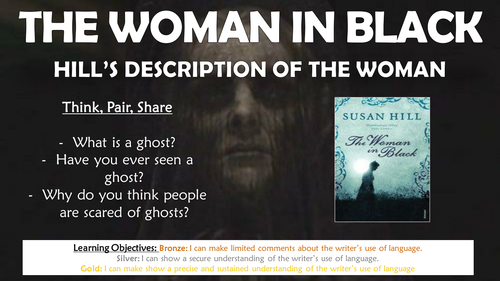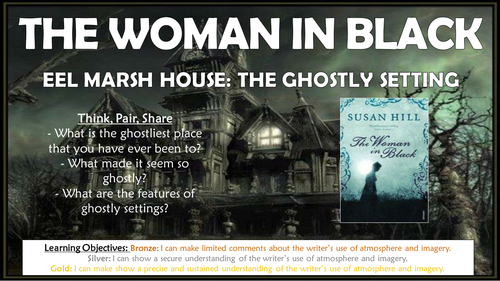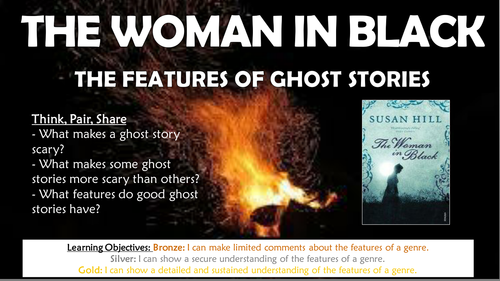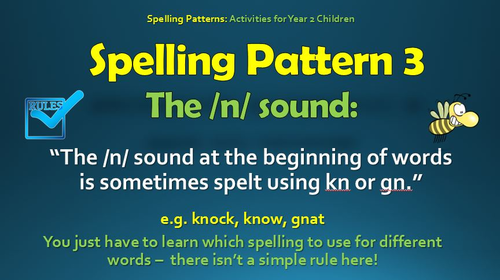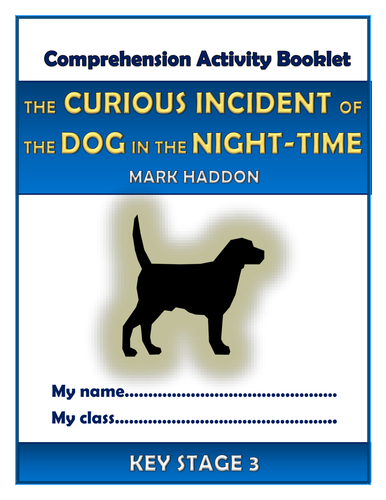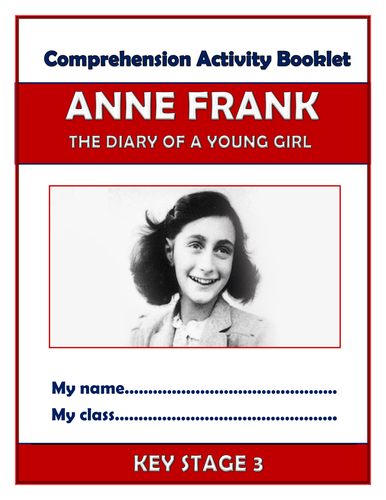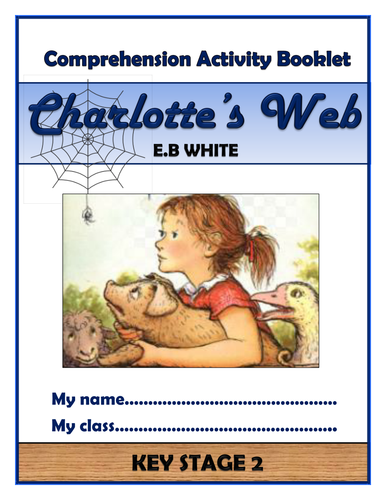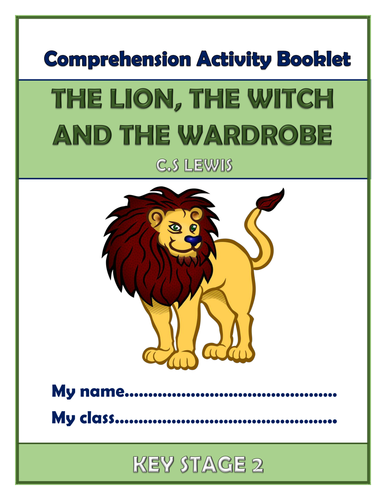
3k+Uploads
1950k+Views
2268k+Downloads
Languages

The Woman in Black: Hill's Description of the Woman!
This engaging and informative lesson enables students to make precise and sustained interpretations regarding Susan Hill’s portrayal of the title character in The Woman in Black. In particular, they consider how the language techniques used (e.g. similes, adverbs and alliteration) are used to introduce and develop the mysterious woman each time that she appears.
The lesson follows a step-by-step learning journey, in which children learn through:
- Defining the key conventions of ghostly characters;
- Understanding and exemplifying key descriptive devices;
- Reading extracts introducing and developing the woman, comprehending key meanings;
- Analysing how the features of Hill's language help to create a chilling portrayal of the woman;
- Peer assessing each other's learning attempts.
Included is:
- Whole lesson PowerPoint - colourful and comprehensive;
- Extracts from 'The Woman in Black' in which the woman appears;
- 'Hill's Language' worksheet (and answer sheet for teachers);
- Cards for descriptive devices sorting activity
- Analysis template with success criteria for creating well-structured responses;
- Comprehensive lesson plan.
There are also opportunities for group learning, peer assessment, and whole class discussion. This was originally taught to mixed ability year 10 groups, but can easily be differentiated for groups of different ages and abilities.
All images are licensed for commercial use, and image rights are listed on the last page of the presentation.

The Woman in Black: Eel Marsh House - The Ghostly Setting!
This engaging and informative lesson enables students to make precise and sustained interpretations regarding Susan Hill’s portrayal of Eel Marsh House in the early chapters of The Woman in Black. In particular, they consider how the language (e.g. similes and pathetic fallacy) are used to introduce and develop the imagery and atmosphere of the house. They also consider how the features of the house (e.g. its isolation and age) relate to the generic conventions of scary settings.
The lesson follows a step-by-step learning journey, in which children learn through:
- Defining the key conventions of ghostly settings;
- Reading extracts introducing Eel Marsh House, and relating the conventions of ghostly settings to the description of Eel Marsh House;
- Identifying and exploring how the features of Hill's language help to create imagery and an atmosphere that surrounds Eel Marsh House;
- Analysing how Hill's language and subject matter are effective in the description of Eel Marsh House;
- Peer assessing each other's learning attempts.
Included is:
- Whole lesson PowerPoint - colourful and comprehensive;
- Extracts from 'The Journey North' and 'Across the Causeway' of The Woman in Black;
- The Features of Ghostly Settings worksheet;
- Analysis template with success criteria for creating well-structured responses;
- Comprehensive lesson plan.
There are also opportunities for group learning, peer assessment, and whole class discussion. This was originally taught to middle-ability year 10 groups, but can easily be differentiated for groups of different ages and abilities.
All images are licensed for commercial use, and image rights are listed on the last page of the presentation.

The Woman in Black: The Features of Ghost Stories!
This engaging and informative lesson enables students to show a detailed and sustained understanding of the conventions of effective ghost stories, through analysis of extracts from Susan Hill's 'The Woman in Black.' They study how individual features of subject matter (such as the setting and the hero) and language (e.g descriptive features) are used to create suspense and tension in the mind of the reader.
The lesson follows a step-by-step learning journey, in which children learn through:
- Defining the key elements of ghost stories;
- Planning a ghost story using the key features;
- Identifying the elements of ghost stories within key extracts of The Woman in Black;
- Analysing the effectiveness of Hill's features of ghost stories in The Woman in Black;
- Peer assessing each other's learning attempts.
Included is:
- Whole lesson PowerPoint - colourful and comprehensive;
- Extracts from the blurb and Chapter 1 of The Woman in Black;
- Template for creating their own ghost stories;
- Analysis template with success criteria for creating well-structured responses;
- Comprehensive lesson plan.
There are also opportunities for group learning, peer assessment, and whole class discussion. This was originally taught to middle-ability year 10 groups, but can easily be differentiated for groups of different ages and abilities.
All images are licensed for commercial use, and image rights are listed on the last page of the presentation.
Bundle Sale

Much Ado About Nothing: Lesson Bundle! (All Lessons, Resources, Plans, Everything!)
This engaging, varied, and informative scheme of learning is designed to help students gain understanding, assessment skills, and key interpretations of William Shakespeare’s tragedy ‘Much Ado About Nothing.’ Made up of a wide-range of interesting and exciting lessons, students should complete this scheme having gathered vital skills in: interpreting the significant meanings of the text, understanding the writer’s ideas within the text, identifying the traits of key characters, settings, and themes, understanding dramatic and language devices, and relating the text to its social and historical context.
Stimulating, visual, and easily adaptable, these lessons provide suggested learning objectives and outcomes for students of a wide-range of abilities - The vast majority of tasks are differentiated to allow for different abilities and needs in your classroom. Each lesson loosely follows this logical learning journey to ensure that students learn in bite-size steps:
- Engaging
- Defining/ Understanding
- Identifying/Remembering
- Analysing/ Creating
- Peer or self evaluating.
All of the lessons are interactive, employ a variety of different teaching and learning methods and styles, and are visually-engaging. Resources, worksheets, and lesson plans are all provided.
Bundle Sale

Much Ado About Nothing Big Bundle! (All Lessons, Resources, Plans, Everything!)
THIS BUNDLE CONTAINS ALL OF THE ‘MUCH ADO ABOUT NOTHING’ LESSONS, PLUS THE COMPREHENSION BOOKLETS (for both KS3 and KS4) AND THE POINTLESS GAME!
This engaging, varied, and informative scheme of learning is designed to help students gain understanding, assessment skills, and key interpretations of William Shakespeare’s tragedy ‘Much Ado About Nothing.’ Made up of a wide-range of interesting and exciting lessons, students should complete this scheme having gathered vital skills in: interpreting the significant meanings of the text, understanding the writer’s ideas within the text, identifying the traits of key characters, settings, and themes, understanding dramatic and language devices, and relating the text to its social and historical context.
Stimulating, visual, and easily adaptable, these lessons provide suggested learning objectives and outcomes for students of a wide-range of abilities - The vast majority of tasks are differentiated to allow for different abilities and needs in your classroom. Each lesson loosely follows this logical learning journey to ensure that students learn in bite-size steps:
- Engaging
- Defining/ Understanding
- Identifying/Remembering
- Analysing/ Creating
- Peer or self evaluating.
All of the lessons are interactive, employ a variety of different teaching and learning methods and styles, and are visually-engaging. Resources, worksheets, and lesson plans are all provided. There is a 20 page comprehension booklet, and also a fun ‘Pointless’ Game included, to enhance your students’ knowledge of the text!

Much Ado About Nothing - Pointless Game!
Based on the popular game show 'Pointless', this resource is perfect for use as a whole lesson resource, enrichment option, or revision tool. Editable, so that you can change to any other topic or change questions. (I've also added a blank template so that you can make your own games from scratch). Containing almost 30 slides of sound clips, engaging visuals, and suitably challenging questions, this resource is effective at both promoting engagement and enhancing learning. There are several full rounds of questions to build or revisit knowledge of characters, plot, and themes in 'The Boy in the Striped Pyjamas.'
Round 1. The characters in Much Ado About Nothing
Round 2. Quotations from the text
Round 3. Settings, Themes, and Objects
Round 4. Shakespearean Comedies
The nature of this game ensures that the resource can challenge students of all levels.
A blank template has also been added, so that you can create your own games!

Much Ado About Nothing - Shakespeare's Language Choices
This engaging, in-depth lesson enables students to understand how Shakespeare uses a range of colourful and varied language choices to develop the theme of social grace in ‘Much Ado about Nothing.’ Much Ado About Nothing contains some of Shakespeare's most vibrant and interesting language, as characters such as Benedick and Claudio use words to jostle for respect around the noble Don Pedro and Leonato. This lesson explores the devices that they use in order to gain favour with their social superiors.
The lesson follows a step-by-step learning journey, in which students learn through:
- Defining and exemplifying different language devices, such as similes, metaphors, alliteration, and puns.
- Taking part in a fun team quiz to identity the language devices used by the main characters in Much Ado About Nothing.
- Understanding the idea of social grace, and learning how it relates to the social hierarchy within the text.
- Completing an essay style response in which they consider how Shakespeare uses language to develop the theme of social grace.
- Peer assessing each other's learning attempts.
Included is:
- Whole lesson PowerPoint - colourful and detailed - just download and teach from it!
- Cards for card-sorting activity;
- Social grace worksheet;
- Analysis template with success criteria for creating well-structured responses;
- Comprehensive lesson plan.
There are also opportunities for group learning, peer assessment, and whole class discussion. This was originally taught to higher ability year 9 and 10 groups, but can easily be differentiated for groups of different ages and abilities.

Year 2 Spelling Patterns - Rules, Activities and Application Tasks!
These resources offer an original and efficient way to approaching the spelling expectations of the 2014 National Curriculum. They contain over 30 slides of spelling rules, 5-minute stand-alone activities, and application tasks to apply spelling patterns to more extended writing opportunities.
This year 2 pack provides comprehensive and varied tasks for approaching spelling rules, such as:
- The /s/ sound spelt with a c before e, i ,and y;
- The /dʒ/ sound at the end of words;
- The /n/ sound at the beginning of words, sometimes spelt kn and gn;
- The /r/ sound at the beginning of words, sometimes spelt wr;
- The /l/ or /əl/ sound at the end of words, spelt le, el, or al;
- The plural of nouns ending /y/, replaced with ies;
- Common homophones;
- Suffixes;
- Apostrophes for possession and omission;
- The year 2 common exception words.
All images used are licensed for commercial use, and are cited on the final slide of the presentation.
Bundle Sale

The Boy in the Striped Pyjamas Resources Bundle!
These varied and engaging resources have been designed to enhance the learning of John Boyne’s ‘The Boy in the Striped Pyjamas.’ They are perfect for aiding and developing comprehension, and also gaining a secure understanding of the social and historical context of the novel.
Included in this resources bundle are:
- The Boy in the Striped Pyjamas Comprehension Activities Booklet - 21 pages of comprehension activities aligned with the text;
- The Boy in the Striped Pyjamas Holocaust Lesson - Enabling students to link the text to its social and historical context;
- The Boy in the Striped Pyjamas Pointless Game - A fun and interactive way of securing understanding of the text.
The Boy in the Striped Pyjamas Knowledge Organiser/ Revision Mat - An hugely detailed resource aiding revision of all aspects of the novel!
All images are licensed for commercial use, and are cited at the end of presentations and in separate documents.
Bundle Sale

Popular Fiction KS3 Comprehension Activity Booklets Big Bundle!
This bundle contains 7 fantastic comprehension activity booklets - each is over 20 pages in length, and focuses upon a different popular classic text. This includes a text by Shakespeare, a play, fiction and non-fiction texts, as prescribed by the National Curriculum.
The resource booklets contain a wide range of age-appropriate, engaging, and meaningful activities - perfect for use throughout class reading of texts or equally in guided reading sessions. They are perfect for aiding the progress of children towards meeting the KS3 comprehension expectations within the National Curriculum framework. Children love learning from these resources, whilst they are also of great use to teachers, as there is explicit information within each task regarding which comprehension strands the task is designed to demonstrate.
There are booklets included for the following texts:
- The Woman in Black
- The Boy in the Striped Pyjamas
- Private Peaceful
- Anne Frank - Diary of a Young Girl
- The Curious Incident of the Dog in the Nighttime
- Stone Cold
- Much Ado About Nothing
There are a huge range of activities! A PDF of each booklet is also provided, to prevent formatting issues.

The Curious Incident of the Dog in the Night-time KS3 Comprehension Activities Booklet!
This resource booklet contains a wide range of age-appropriate, engaging, and meaningful comprehension activities for use throughout the reading of Mark Haddon's 'The Curious Incident of the Dog in the Night-time.' Teachers have found them particularly useful in comprehension or guided reading sessions. They are perfect for aiding the progress of children towards meeting the KS3 expectations within the new National Curriculum framework. Children have found these resources extremely engaging, and for teachers there is explicit information within each task regarding which comprehension strands the task is designed to demonstrate. They also relate to key extracts, characters, and themes from the story, ensuring that children gain a deep understanding of the text.
Activities within the booklet include:
- 'Context: Asperger's Syndrome' - to enable students to demonstrate that they can: 'Know the purpose, audience and context of the writing and drawing on this knowledge to support comprehension.'
- 'Haddon's Description - The Police Station' - to enable students to demonstrate that they can: 'Know how language, including figurative language, vocabulary choice, grammar, text structure and organisational features, present meaning.'
- 'Ed Boone' - to enable students to demonstrate that they can: 'Study setting, plot, and characterisation, and the effects of these.'
- 'Vocabulary Inspector' - to enable students to demonstrate that they can: 'Learn new vocabulary, relating it explicitly to known vocabulary and understanding it with the help of context and dictionaries.'
Plus many, many more activities (the booklet is 21 pages in length!) I've also added it as a PDF in case the formatting differs on your computer.
All images are licensed for commercial use, and are cited on a separate document (included).

Anne Frank - Diary of a Young Girl - KS3 Comprehension Activities Booklet!
This resource booklet contains a wide range of age-appropriate, engaging, and meaningful comprehension activities for use throughout the reading of Anne Frank's 'Diary of a Young Girl.' Teachers have found them particularly useful in comprehension or guided reading sessions. They are perfect for aiding the progress of children towards meeting the KS3 expectations within the new National Curriculum framework. Children have found these resources extremely engaging, and for teachers there is explicit information within each task regarding which comprehension strands the task is designed to demonstrate. They also relate to key extracts, characters, and themes from the story, ensuring that children gain a deep understanding of the text.
Activities within the booklet include:
- 'Context: The Holocaust' - to enable students to demonstrate that they can: 'Know the purpose, audience and context of the writing and drawing on this knowledge to support comprehension.'
- 'Anne's Description - The Annex' - to enable students to demonstrate that they can: 'Know how language, including figurative language, vocabulary choice, grammar, text structure and organisational features, present meaning.'
- 'Otto Frank and 'Peter van Daan' - to enable students to demonstrate that they can: 'Study setting, plot, and characterisation, and the effects of these.'
- 'Vocabulary Inspector' - to enable students to demonstrate that they can: 'Learn new vocabulary, relating it explicitly to known vocabulary and understanding it with the help of context and dictionaries.'
Plus many, many more activities (the booklet is 21 pages in length!) I've also added it as a PDF in case the formatting differs on your computer.
All images are licensed for commercial use, and are cited on a separate document (included).

The Woman in Black - KS3 Comprehension Activities Booklet!
This resource booklet contains a wide range of age-appropriate, engaging, and meaningful comprehension activities for use throughout the reading of Susan Hill's 'The Woman in Black.' Teachers have found them particularly useful in comprehension or guided reading sessions. They are perfect for aiding the progress of children towards meeting the KS3 expectations within the new National Curriculum framework. Children have found these resources extremely engaging, and for teachers there is explicit information within each task regarding which comprehension strands the task is designed to demonstrate. They also relate to key extracts, characters, and themes from the story, ensuring that children gain a deep understanding of the text.
Activities within the booklet include:
- 'Context: The Rural North' - to enable students to demonstrate that they can: 'Know the purpose, audience and context of the writing and drawing on this knowledge to support comprehension.'
- 'Hill's Description - The Horse and Trap' - to enable students to demonstrate that they can: 'Know how language, including figurative language, vocabulary choice, grammar, text structure and organisational features, present meaning.'
- 'Mr Jerome' and 'The Woman in Black' - to enable students to demonstrate that they can: 'Study setting, plot, and characterisation, and the effects of these.'
- 'Vocabulary Inspector' - to enable students to demonstrate that they can: 'Learn new vocabulary, relating it explicitly to known vocabulary and understanding it with the help of context and dictionaries.'
Plus many, many more activities (the booklet is 21 pages in length!) I've also added it as a PDF in case the formatting differs on your computer.
All images are licensed for commercial use, and are cited on a separate document (included).

Private Peaceful - KS3 Comprehension Activities Booklet!
This resource booklet contains a wide range of age-appropriate, engaging, and meaningful comprehension activities for use throughout the reading of Michael Morpurgo’s ‘Private Peaceful.’ Teachers have found them particularly useful in comprehension or guided reading sessions. They are perfect for aiding the progress of children towards meeting the KS3 expectations within the new National Curriculum framework. Children have found these resources extremely engaging, and for teachers there is explicit information within each task regarding which comprehension strands the task is designed to demonstrate. They also relate to key extracts, characters, and themes from the story, ensuring that children gain a deep understanding of the text.
Activities within the booklet include:
- ‘Context: World War One’ - to enable students to demonstrate that they can: ‘Know the purpose, audience and context of the writing and drawing on this knowledge to support comprehension.’
- ‘Morpurgo’s Description’ - to enable students to demonstrate that they can: ‘Know how language, including figurative language, vocabulary choice, grammar, text structure and organisational features, present meaning.’
- ‘Horrible Hanley’ - to enable students to demonstrate that they can: ‘Study setting, plot, and characterisation, and the effects of these.’
- ‘Vocabulary Inspector’ - to enable students to demonstrate that they can: ‘Learn new vocabulary, relating it explicitly to known vocabulary and understanding it with the help of context and dictionaries.’
Plus many, many more activities (the booklet is 21 pages in length!) I’ve also added it as a PDF in case the formatting differs on your computer.
All images are licensed for commercial use, and are cited on a separate document (included).

Much Ado About Nothing - KS3 Comprehension Activities Booklet!
This resource booklet contains a wide range of age-appropriate, engaging, and meaningful comprehension activities for use throughout the reading of William Shakespeare's 'Much Ado About Nothing.' Teachers have found them particularly useful in comprehension or guided reading sessions. They are perfect for aiding the progress of children towards meeting the KS3 expectations within the new National Curriculum framework. Children have found these resources extremely engaging, and for teachers there is explicit information within each task regarding which comprehension strands the task is designed to demonstrate. They also relate to key extracts, characters, and themes from the story, ensuring that children gain a deep understanding of the text.
Activities within the booklet include:
- 'Context: Life in Shakespeare's Times' - to enable students to demonstrate that they can: 'Know the purpose, audience and context of the writing and drawing on this knowledge to support comprehension.'
- 'Shakespeare's Description' - to enable students to demonstrate that they can: 'Know how language, including figurative language, vocabulary choice, grammar, text structure and organisational features, present meaning.'
- 'Hero' - to enable students to demonstrate that they can: 'Study setting, plot, and characterisation, and the effects of these.'
- 'Vocabulary Inspector' - to enable students to demonstrate that they can: 'Learn new vocabulary, relating it explicitly to known vocabulary and understanding it with the help of context and dictionaries.'
Plus many, many more activities (the booklet is 22 pages in length!) I've also added it as a PDF in case the formatting differs on your computer.
All images are licensed for commercial use, and are cited on a separate document (included).

Stone Cold - KS3 Comprehension Activities Booklet!
This resource booklet contains a wide range of age-appropriate, engaging, and meaningful comprehension activities for use throughout the reading of Robert Swindells' 'Stone Cold.' Teachers have found them particularly useful in comprehension or guided reading sessions. They are perfect for aiding the progress of children towards meeting the KS3 expectations within the new National Curriculum framework. Children have found these resources engaging, and for teachers there is explicit information within each task regarding which comprehension strands the task is designed to demonstrate. They also relate to key extracts, characters, and themes from the story, ensuring that children gain a deep understanding of the text.
Activities within the booklet include:
- 'Context: Homelessness in London' - to enable students to demonstrate that they can: 'Know the purpose, audience and context of the writing and drawing on this knowledge to support comprehension.'
- 'Swindell's Description' - to enable students to demonstrate that they can: 'Know how language, including figurative language, vocabulary choice, grammar, text structure and organisational features, present meaning.'
- 'Ginger' - to enable students to demonstrate that they can: 'Study setting, plot, and characterisation, and the effects of these.'
- 'Vocabulary Inspector' - to enable students to demonstrate that they can: 'Learn new vocabulary, relating it explicitly to known vocabulary and understanding it with the help of context and dictionaries.'
Plus many, many more activities (the booklet is 21 pages in length!) I've also added it as a PDF in case the formatting differs on your computer.
All images are licensed for commercial use, and are cited on a separate document (included).
Bundle Sale

Popular Fiction KS2 Comprehension Activity Booklets Big Bundle!
This bundle contains 7 fantastic comprehension activity booklets - each is over 20 pages in length, and focuses upon a different popular classic text.
The resource booklets contain a wide range of age-appropriate, engaging, and meaningful activities - perfect for use throughout class reading of texts or equally in guided reading sessions. They are perfect for aiding the progress of children towards meeting the KS2 comprehension expectations within the National Curriculum framework. Children love learning from these resources, whilst they are also of great use to teachers, as there is explicit information within each task regarding which comprehension strands the task is designed to demonstrate.
There are booklets included for the following texts:
- The Hobbit - J.R.R Tolkien
- A Series of Unfortunate Events -The Bad Beginning - Lemony Snicket
- Billionaire Boy - David Walliams
- Charlotte’s Web - E.B White
- Holes - Louis Sachar
- Skellig - David Almond
- The Lion, The Witch, and The Wardrobe - C.S Lewis
There are a huge range of activities! A PDF of each booklet is also provided, to prevent formatting issues.

Charlotte's Web - KS2 Comprehension Activities Booklet!
This resource booklet contains a wide range of age-appropriate, engaging, and meaningful comprehension activities for use throughout the reading of E.B White's 'Charlotte's Web.' Teachers have found them particularly useful in comprehension or guided reading sessions. They are perfect for aiding the progress of children towards meeting the upper KS2 expectations within the new National Curriculum framework. Children love learning from these resources, whilst they are also of great use to teachers, as there is explicit information within each task regarding which comprehension strands the task is designed to demonstrate. They also relate to key extracts, characters, and themes from the story, ensuring that children gain a deep understanding of the text.
Activities within the booklet include:
- 'An Interview with John Arable' - to enable students to demonstrate that they can: 'Understand what is read by drawing on information from more than one paragraph, identifying key details that support the main ideas, and using quotations for illustration;'
- 'White's Description' - to enable students to demonstrate that they can: 'Explain meanings of words that they know and ask the meaning of new words. Link the meaning of new words to words that they already know;'
- 'Charlotte and 'Wilbur' - to enable students to demonstrate that they can: 'Understand what is read by drawing on information from more than one paragraph, identifying key details that support the main ideas, and using quotations for illustration;'
- 'Figurative Language in 'Charlotte's Web' - to enable students to demonstrate that they can: 'Discuss and evaluate how authors use language, including figurative language, to create an impact on the reader.'
Plus many, many more activities (the booklet is 21 pages in length!) I've also added it as a PDF in case the formatting differs on your computer.
All images are licensed for commercial use, and are cited on a separate document (included).

A Series of Unfortunate Events - The Bad Beginning - KS2 Comprehension Activities Booklet!
This resource booklet contains a wide range of age-appropriate, engaging, and meaningful comprehension activities for use throughout the reading of Lemony Snicket's 'A Series of Unfortunate Events - The Bad Beginning.' Teachers have found them particularly useful in comprehension or guided reading sessions. They are perfect for aiding the progress of children towards meeting the upper KS2 expectations within the new National Curriculum framework. Children love learning from these resources, whilst they are also of great use to teachers, as there is explicit information within each task regarding which comprehension strands the task is designed to demonstrate. They also relate to key extracts, characters, and themes from the story, ensuring that children gain a deep understanding of the text.
Activities within the booklet include:
- 'An Interview with Violet' - to enable students to demonstrate that they can: 'Understand what is read by drawing on information from more than one paragraph, identifying key details that support the main ideas, and using quotations for illustration;'
- 'Snicket's Description' - to enable students to demonstrate that they can: 'Explain meanings of words that they know and ask the meaning of new words. Link the meaning of new words to words that they already know;'
- 'Count Olaf' - to enable students to demonstrate that they can: 'Understand what is read by drawing on information from more than one paragraph, identifying key details that support the main ideas, and using quotations for illustration;'
- 'Figurative Language in 'A Series of Unfortunate Events' - to enable students to demonstrate that they can: 'Discuss and evaluate how authors use language, including figurative language, to create an impact on the reader.'
Plus many, many more activities (the booklet is 21 pages in length!) I've also added it as a PDF in case the formatting differs on your computer.
All images are licensed for commercial use, and are cited on a separate document (included).

The Lion, The Witch, and The Wardrobe KS2 Comprehension Activities Booklet!
This resource booklet contains a wide range of age-appropriate, engaging, and meaningful comprehension activities for use throughout the reading of C.S Lewis's 'The Lion, The Witch, and The Wardrobe.' Teachers have found them particularly useful in comprehension or guided reading sessions. They are perfect for aiding the progress of children towards meeting the upper KS2 expectations within the new National Curriculum framework. Children love learning from these resources, whilst they are also of great use to teachers, as there is explicit information within each task regarding which comprehension strands the task is designed to demonstrate. They also relate to key extracts, characters, and themes from the story, ensuring that children gain a deep understanding of the text.
Activities within the booklet include:
- 'An Interview with Peter' - to enable students to demonstrate that they can: 'Understand what is read by drawing on information from more than one paragraph, identifying key details that support the main ideas, and using quotations for illustration;'
- 'Lewis's Description' - to enable students to demonstrate that they can: 'Explain meanings of words that they know and ask the meaning of new words. Link the meaning of new words to words that they already know;'
- 'Aslan' - to enable students to demonstrate that they can: 'Understand what is read by drawing on information from more than one paragraph, identifying key details that support the main ideas, and using quotations for illustration;'
- 'Figurative Language in The Lion, The Witch, and The Wardrobe' - to enable students to demonstrate that they can: 'Discuss and evaluate how authors use language, including figurative language, to create an impact on the reader.'
Plus many, many more activities (the booklet is 21 pages in length!) I've also added it as a PDF in case the formatting differs on your computer.
All images are licensed for commercial use, and are cited on a separate document (included).

